
Stephanomeria is a genus of North American plants also known as wirelettuce, belonging to the tribe Cichorieae within the family Asteraceae.

Salvia brandegeei is a perennial evergreen shrub in the mint family known by the common names Santa Rosa Island sage or Brandegee's sage. It is a fragrant plant characterized by lavender flowers and dark green leaves. For many years, it was thought to be native only to Santa Rosa Island, one of the Channel Islands of California, until it was discovered along the coast of Baja California. It is threatened by development and mining along the mainland portions of its range, but otherwise has a stable population on Santa Rosa Island.

Mary Katharine Brandegee was an American botanist known for her comprehensive studies of flora in California.

Townshend Stith Brandegee was an American botanist. He was an authority on the flora of Baja California and the Channel Islands of California.
Brickellia peninsularis is a Mexican species of flowering plants in the family Asteraceae. It is native to western Mexico in the states of Baja California, Baja California Sur, and Colima.
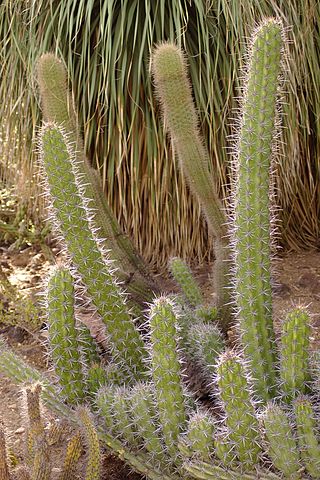
Stenocereus gummosus is a flowering plant in the family Cactaceae that is found in Baja California, Mexico at elevations of 9 to 134 meters
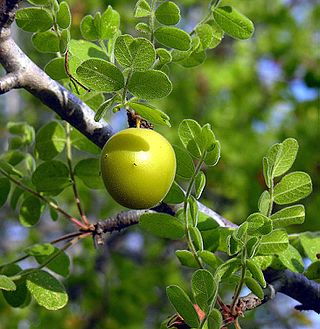
Cyrtocarpa edulis is a species of perennial sarcocaulescent tree commonly known as the Cimarrón plum or Cape wild-plum. It is in the genus Cyrtocarpa, and is endemic to Baja California Sur. This plant is characterized by fleshy stems, twisted branches and an edible drupe.
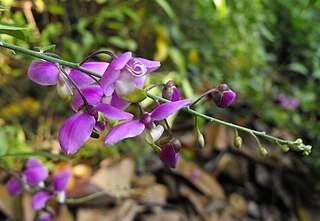
Asemeia apopetala is a species of flowering plant in the milkwort family commonly known as Brandegee milkwort or rama mora. It is a shrub or a small tree characterized by showy pink to magenta flowers that bloom from September to November or any time of year with ample rainfall. It was first described in 1889 and is endemic to Baja California Sur, Mexico. It is the type for the subgenus Apopetala of Asemeia.

Dudleya pauciflora is a species of succulent plant in the stonecrop family known by the common name few-flower liveforever. It is characterized by its small crowded rosettes of narrow leaves and its colorful inflorescence with red-yellow flowers. Found growing on rocky outcrops and cliffs in the high elevation mountains of the Sierra de San Pedro Martir and the Sierra de San Borja, it is endemic to the state of Baja California, Mexico.

Gambelia is a genus of flowering plants in the Antirrhineae tribe of the plantain family commonly known as bush snapdragons. This genus is native to northwestern Mexico, particularly the Baja California Peninsula, but species are also found on the coast of Sonora, Guadalupe Island, and the Channel Islands of California. The genus is named in honor of William Gambel (1823–1849), an American naturalist, ornithologist, and botanist.

Dudleya nubigena is a species of succulent plants in the family Crassulaceae. It is a rosette forming perennial with flattish leaves. Endemic to southern Baja California Sur, the species is found in the Sierra de la Laguna and the surrounding lowlands, a small southern portion of the Sierra de la Giganta, and on Isla Espíritu Santo, with a subspecies endemic to Cerralvo Island.

Nahuatlea aborescens is a species of tree in the Composite family endemic to the Cape region and Cerralvo Island of Baja California Sur, commonly known as ocote. It grows up to 8 meters tall, with monoecious tan-colored flowers and short, leafy branchlets. It was formerly in the genus Gochnatia, where it was known commonly as the tree gochnatia.

Lysiloma candidum, most commonly known as the palo blanco, is a tree of the family Fabaceae near-endemic to the Baja California Peninsula in Mexico. It may grow to a height of 10 metres (33 ft) and is one of the few spineless woody legumes in the region. It has compound leaves with oval gray-green leaflets. The creamy-white, globose clusters of flowers bloom in March through May and perfume the air with a light, spicy fragrance. The flowers are followed by red-brown pods up to 15 centimetres (5.9 in) long that hang delicately on the thin branches. This species is distributed throughout the Baja California Peninsula, from Rancho El Barril in southern Baja California state to the Cape region of Baja California Sur, and is also very rarely found in the state of Sonora.
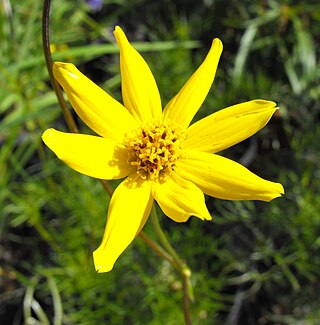
Bidens nudata is a species of perennial plant in the family Asteraceae commonly known as the Cape beggar's tick or Baja tickseed. This species is endemic to the Sierra de la Laguna and the Sierra de las Cacachilas of Baja California Sur, Mexico. It is characterized by a mounding habit, pinnate green leaves and large yellow daisy-like flowers. This species has found uses in horticulture as an ornamental, providing a drought-tolerant and durable plant for the garden.

Nolina beldingii is a species of perennial flowering plant in the family Asparagaceae known commonly as the Cape nolina or Belding's beargrass. It is an arborescent monocot growing up to 7 metres (23 ft) high, with fissured bark on a trunk topped with leaf rosettes. The narrow leaves are up to 1.15 m (3.8 ft) long, and are used as thatching by local peoples. This species is endemic to Baja California Sur in Mexico, where it grows only in the highest reaches of the Sierra de la Laguna. It is found primarily in oak forests at elevations over 1,000 m (3,300 ft) along rocky granite outcrops.

Schoepfia californica is a species of flowering plant in the Schoepfiaceae commonly known as the California schoepfia, iguajil, and candelillo. It is a large shrub or small tree with grayish bark, smooth turquoise-colored leaves, and small red flowers. It is endemic to the Baja California peninsula, and is commonly found in desert flats, slopes, and washes in an area from the Bahia de Los Angeles to the Cape region at the tip of the peninsula.
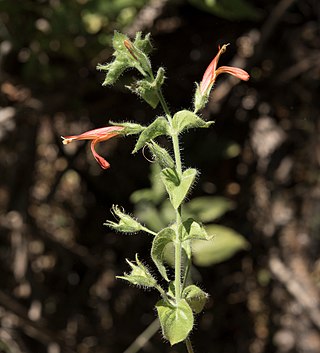
Justicia purpusii is a species of flowering plant in the Acanthus family commonly known as Purpus' hummingbird flower or chuparosa. This shrub is characterized by long orange-red tubular flowers that bloom from November to April. It is endemic to the Cape region of Baja California Sur, Mexico, where it is found growing in tropical deciduous forest and thorn scrub in canyons and along wet slopes. It is similar to its more northern relative adapted to drier climates, Justicia californica. Phylogenetic analysis has shown that both species are closely related and form a clade.

Gambelia juncea is a species of flowering shrub in the plantain family commonly known as the Baja California bush snapdragon or Baja bush snapdragon. Gambelia juncea is a highly variable woody perennial to 1 m (3.3 ft) characterized by long, arching, reed-like stems and showy, bright red, two-lipped tubular flowers. Native to the Baja California peninsula and coastal Sonora, this species is widespread in the region across numerous habitats and has several varieties. It was formerly placed in the primarily South American genus Galvezia, but taxonomic studies have supported the reclassification of the two North American species into Gambelia. This species, with a number of cultivars, is widely used as an ornamental shrub for xeriscaping, erosion control, native plant gardens, and wildlife gardens.

Rumfordia connata is a species of flowering plant in the Millerieae tribe of the composite family commonly known as the Cape rumfordia. A conspicuous yellow-flowered shrubby perennial growing to 2 metres (6.6 ft) high, this species is endemic to the high elevations of the Sierra de la Laguna mountains of Baja California Sur where it is uncommonly found. Rumfordia connata was first discovered and later described by Townshend Stith Brandegee in 1892.

Castilleja guadalupensis is an extinct species of plant in the broomrape family Orobanchaceae commonly known as the Guadalupe paintbrush. The plant was only found on the central and northern portions of Guadalupe Island, an eastern Pacific island of Mexico. It was one of two endemic species of Castilleja to the island, the other, Castilleja fruticosa, mainly surviving on offshore islets.



















